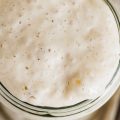Forget the notion that sourdough is just a vehicle for avocado toast or a sidekick to your morning eggs. You can transform your humble loaf into a umami-packed powerhouse. We’re not just talking about adding a sprinkle of herbs here—we’re diving headfirst into a world where sourdough flirts with the savory depths usually reserved for main courses. Get ready to create loaves that are less ‘daily bread’ and more ‘standalone feast.’

Table of Contents
- Ingredients for Savory Sourdough
- Savory Sourdough Starter
- Dough Prep
- Fermentation and Proofing
- Baking Techniques
- Savory Sourdough Recipes
- Serving Suggestions
- Sourdough Umami Bomb!
- How to Make Sourdough More Savory: FAQs
Ingredients for Savory Sourdough
There are so many savory ingredients you can add into your sourdough; you might remember I mentioned some of them from my post about How to Make Sourdough More Salty.
If you’re a fan of Mediterranean flavors, olives are a must-try addition. Roughly chop the olives and fold them into your dough during the final shaping stage for a burst of flavor in every bite.
Cheese and bread are a match made in heaven. Experiment with different types of cheese to find your perfect savory combination. Sharp cheddar, nutty Parmesan, or creamy goat cheese all make excellent choices. Grate or crumble the cheese and mix it into your dough for a deliciously cheesy sourdough loaf that will have you coming back for more.
Fresh herbs are a game-changer when it comes to enhancing the flavor of your savory sourdough. Rosemary and thyme are classic choices that pair beautifully with the tangy flavor of sourdough. Chop the herbs finely and add them to your dough during the mixing stage. As the bread bakes, the herbs will release their aromatic oils, infusing your loaf with a mouthwatering herbaceous flavor.
For the ultimate flavor, no further than garlic (my personal fave). Roast a head of garlic until it’s soft and sweet, then squeeze out the cloves and mix them into your dough. The mellow, caramelized flavor of roasted garlic will permeate every bite of your bread, creating a loaf that’s irresistibly savory and utterly addictive.
Savory Sourdough Starter
While most of the savory magic happens when you mix your dough, did you know that you can actually infuse your sourdough starter with savory notes? That’s right, by modifying your starter, you can lay the foundation for a loaf that’s bursting with savory goodness from the very beginning.
To give your starter a savory twist, consider adding small amounts of savory ingredients like finely chopped herbs, grated cheese, or even a pinch of garlic powder. The key is to start small and gradually increase the amount of savory additions over a few feedings, allowing your starter to adapt and develop complex flavors.
When feeding your sourdough starter, stick to the same ratio of flour and water that you normally use. However, you can experiment with different types of flour to enhance the savory profile. Try incorporating a small percentage of whole wheat, rye, or even chickpea flour for an extra nutty, earthy flavor that complements savory ingredients beautifully.
As your savory starter ferments, the flavors will continue to develop and intensify. The longer the fermentation process, the more complex and robust the savory notes will become.
Don’t be afraid to let your starter ferment a bit longer than usual to really let those savory elements shine through in your final loaf.

Dough Prep
When incorporating savory ingredients, knead thoroughly to ensure even distribution. Get your hands in there and give your dough some love – you’ll be rewarded with a loaf that’s bursting with flavor in every bite.
For ingredients like herbs, garlic, and cheese, it’s best to mix them in during the initial stages of dough preparation. This allows the flavors to meld seamlessly with the dough as it ferments. For more delicate ingredients like sun-dried tomatoes or olives, consider adding them during the final shaping stage to preserve their texture and integrity.
Just like you need a break after a long day, your dough needs time to rest and relax. This is especially important when working with savory ingredients, as the dough may require a bit more time to develop flavor complexity. After kneading, let your dough rest for a good 30 minutes to an hour before proceeding to the next step. This resting period allows the gluten to relax, making shaping easier and resulting in a more tender crumb.
Fermentation and Proofing
The longer you let your dough ferment, the more pronounced and complex these flavors become.
While a longer fermentation can lead to a more flavorful loaf, it’s important to find the sweet spot. Over-fermenting your dough can result in a loaf that’s too sour or even bitter. When working with savory ingredients, aim for a fermentation time of around 8-12 hours at room temperature. This allows the flavors to develop without overwhelming the delicate balance of your sourdough.
Once your dough has completed its bulk fermentation, it’s time to shape and proof your loaf. Proofing is the final rise before baking, and it’s essential for achieving a well-structured, flavorful bread. When proofing savory sourdough, be patient and let the dough rise until it has nearly doubled in size. This can take anywhere from 2-4 hours, depending on the temperature and humidity of your proofing environment.
To ensure your sourdough rises to its full potential, create a warm, humid proofing environment. You can proof your dough in a covered bowl or a proofing basket lined with a floured kitchen towel. For an extra burst of savory flavor, consider dusting your proofing basket with herbs or grated cheese before adding your dough. This will infuse your loaf with an extra layer of deliciousness as it rises.
Baking Techniques
To get that crispy, golden exterior, preheat your oven to a scorching 450°F (230°C). This high heat will create a burst of steam when your dough hits the oven, resulting in a crust that’s crunchy on the outside and soft and chewy on the inside.
While every oven is different, a good rule of thumb is to bake your loaf for around 35-45 minutes. Keep a watchful eye on your bread during the last 10 minutes of baking, as this is when the crust will develop its signature color and texture. If you’re unsure, use a thermometer to check the internal temperature of your loaf – it should read around 200°F (93°C) when it’s ready.
One of the secrets to achieving a perfectly crispy crust on your savory sourdough is steam. When you introduce steam into your oven during the first few minutes of baking, it helps to create a moist environment that allows the dough to expand and develop a crisp, shiny crust. To create steam, place a shallow pan of water on the bottom rack of your oven before preheating. Alternatively, you can spritz your loaf with water using a spray bottle just before placing it in the oven.
A Dutch oven or a covered cast-iron pot can work wonders for creating a steamy environment that leads to a perfectly crisp crust. If you don’t have a Dutch oven, you can create a similar effect by placing a large, inverted metal bowl over your loaf during the first 20 minutes of baking. This will trap the steam and encourage that coveted crust development.
Prices pulled from the Amazon Product Advertising API on:
Product prices and availability are accurate as of the date/time indicated and are subject to change. Any price and availability information displayed on [relevant Amazon Site(s), as applicable] at the time of purchase will apply to the purchase of this product.
Savory Sourdough Recipes
It’s time to put your skills to the test with some mouthwatering recipes!
Sun-Dried Tomato and Basil Sourdough
Transport yourself to the sun-drenched hills of Tuscany with this irresistible Sun-Dried Tomato and Basil Sourdough. The sweetness of the sun-dried tomatoes pairs perfectly with the fragrant basil, creating a loaf that’s bursting with Mediterranean flavor.
Ingredients
- 500g sourdough starter
- 500g bread flour
- 300g water
- 10g salt
- 100g sun-dried tomatoes, roughly chopped
- 20g fresh basil leaves, finely chopped
Instructions
- In a large bowl, mix together the sourdough starter, flour, water, and salt until a shaggy dough forms.
- Knead the dough for 10-15 minutes until smooth and elastic.
- Fold in the sun-dried tomatoes and basil leaves until evenly distributed.
- Place the dough in a lightly oiled bowl, cover, and let it ferment for 8-12 hours.
- Shape the dough into a loaf, place it in a proofing basket, and let it rise for another 2-3 hours.
- Preheat your oven to 450°F (230°C) with a Dutch oven inside.
- Carefully transfer the loaf to the preheated Dutch oven, score the top, and bake for 35-40 minutes.
- Remove the loaf from the Dutch oven and let it cool completely on a wire rack before slicing and serving.
Caramelized Onion and Gruyere Sourdough
Caramelized onions and nutty Gruyere cheese come together in perfect harmony in this decadent Caramelized Onion and Gruyere Sourdough. The sweetness of the onions balances the richness of the cheese, creating a loaf that’s both comforting and indulgent.
Ingredients
- 500g sourdough starter
- 500g bread flour
- 300g water
- 10g salt
- 200g caramelized onions
- 150g Gruyere cheese, grated
Instructions
- Follow steps 1-2 from the Sun-Dried Tomato and Basil Sourdough recipe.
- Fold in the caramelized onions and Gruyere cheese until evenly distributed.
- Continue with steps 4-8 from the Sun-Dried Tomato and Basil Sourdough recipe, adjusting baking time as needed.
Roasted Garlic and Rosemary Sourdough
For a loaf that’s equal parts aromatic and flavorful, look no further than this Roasted Garlic and Rosemary Sourdough. The mellow sweetness of roasted garlic pairs beautifully with the woody, herbaceous notes of fresh rosemary, creating a bread that’s simply irresistible.
Ingredients
- 500g sourdough starter
- 500g bread flour
- 300g water
- 10g salt
- 1 head of garlic, roasted and mashed
- 20g fresh rosemary leaves, finely chopped
Instructions
- Follow steps 1-2 from the Sun-Dried Tomato and Basil Sourdough recipe.
- Fold in the roasted garlic and rosemary leaves until evenly distributed.
- Continue with steps 4-8 from the Sun-Dried Tomato and Basil Sourdough recipe, adjusting baking time as needed.

Serving Suggestions
- Try serving your savory sourdough alongside a hearty bowl of soup or a crisp, fresh salad for a satisfying and well-rounded meal. For a more substantial option, use thick slices of savory sourdough as the base for an open-faced sandwich piled high with your favorite toppings.
- Take your cheese board to the next level by incorporating slices of savory sourdough. The tangy, complex flavors of the bread pair beautifully with a variety of cheeses, from creamy brie to sharp cheddar. Add some cured meats, fresh fruits, and a drizzle of honey for a stunning and delicious spread that’s sure to impress your guests.
- Don’t limit yourself to thinking of savory sourdough as just a vehicle for other foods. It can also shine as a side dish in its own right. Try tearing a loaf into bite-sized pieces, tossing them with olive oil and herbs, and baking until crispy for a flavorful and addictive crouton alternative. Or, grill thick slices of savory sourdough and serve them alongside your favorite grilled meats and vegetables for a summer-inspired feast.
- Sometimes, the best way to enjoy savory sourdough is in its purest form. Slice a still-warm loaf and serve it with a dish of high-quality olive oil for dipping. The richness of the oil complements the tangy, complex flavors of the bread, creating a simple yet luxurious eating experience. For an added burst of flavor, sprinkle the oil with a pinch of flaky sea salt or a blend of dried herbs before diving in.
Sourdough Umami Bomb!
Your next umami-rich masterpiece is just a fold and proof away. Go forth and let your savory sourdough revolutionize your kitchen—and maybe even your neighborhood!
How to Make Sourdough More Savory: FAQs
How to make sourdough more flavorful?
To enhance the flavor of your sourdough, try using a mature starter, extend the fermentation time, and incorporate whole grains or add-ins like herbs, cheese, or olives. Experiment with different flour combinations and ratios to find the perfect balance of flavors. Lastly, allow your loaf to cool completely before slicing to let the flavors develop fully.
How to make sourdough bread that doesn’t taste sour?
To make a milder sourdough, use a young starter (4-8 hours after feeding), reduce the amount of starter in your recipe, and shorten the fermentation time. Use a higher proportion of bread flour to whole grain flour, and avoid adding acidic ingredients like yogurt or vinegar. Finally, bake your loaf as soon as it’s proofed to prevent excessive sourness.
What makes sourdough bread taste better?
Several factors contribute to better-tasting sourdough: using a well-maintained starter, selecting high-quality flour, allowing adequate fermentation time, and creating a flavorful crust. Experimenting with different flour blends, hydration levels, and baking techniques can also enhance the taste. Lastly, letting the bread cool completely before slicing allows the flavors to meld and develop, resulting in a more delicious loaf.
Why does my sourdough taste bland?
Bland sourdough can result from several factors: using an inactive or weak starter, not allowing enough fermentation time, or overproofing the dough. Insufficient salt or a lack of flavorful ingredients can also contribute to a bland taste. To improve flavor, use a mature starter, extend fermentation, and experiment with different flour combinations, add-ins, and baking techniques.













